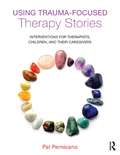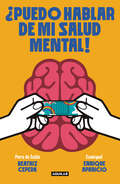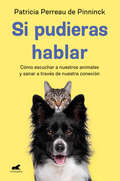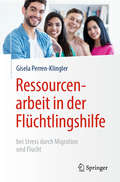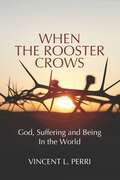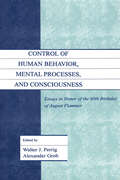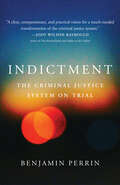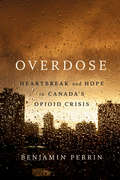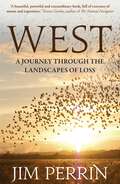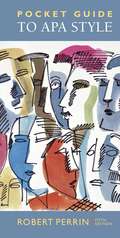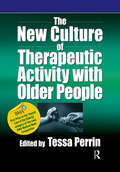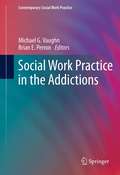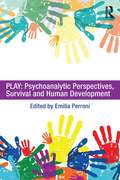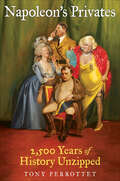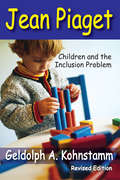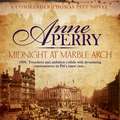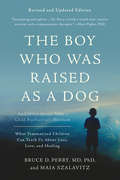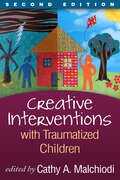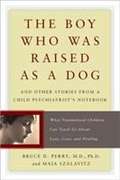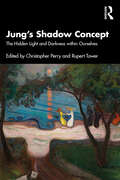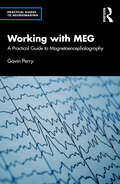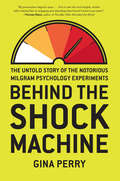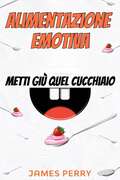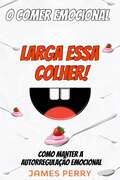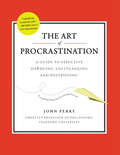- Table View
- List View
Using Trauma-Focused Therapy Stories: Interventions for Therapists, Children, and Their Caregivers
by Pat PernicanoUsing Trauma-Focused Therapy Stories is a groundbreaking treatment resource for trauma-informed therapists who work with abused and neglected children ages nine years and older as well as their caregivers. The therapy stories are perfect accompaniments to evidence-based treatment approaches and provide the foundation for psychoeducation and intervention with the older elementary-aged child or early pre-teen. Therapists will also benefit from the inclusion of thorough guides for children and caregivers, which illustrate trauma and developmental concepts in easy-to-understand terms. The psychoeducational material in the guides, written at a third- to fourth-grade reading level, may be used within any trauma-informed therapy model in the therapy office or sent-home for follow-up. Each therapy story illustrates trauma concepts, guides trauma narrative and cognitive restructuring work, and illuminates caregiver blind spots; the caregiver stories target issues that often become barriers to family trauma recovery. No therapist who works with young trauma survivors will want to be without this book, and school-based professionals, social workers, psychologists and others committed to working with traumatized children will find the book chock-full of game-changing ideas for their practice.
¿Puedo hablar de mi salud mental!
by Perra de Satán EsnorquelDos personas cucú te explican que ir al psicólogo no es ninguna locura. Desde su exitoso pódcast, ¿Puedo hablar!, Enrique Aparicio (Esnórquel) y Beatriz Cepeda (Perra de Satán) rompen tabúes y tratan con naturalidad cuestiones como la ansiedad, la depresión, los trastornos de la conducta alimentaria o la ideación suicida. El libro ¿Puedo hablar de mi salud mental! es el puente que quieren tender a todas las personas que intuyen que hay algo en su vida que falla, pero no se atreven a pedir ayuda. Su ejemplo, el de dos personas para las que la terapia ha sido fundamental, puede servir de impulso para quienes saben que deben arreglar algo en su cabeza, aunque no sepan bien lo que es. «Durante mucho tiempo creí que el sufrimiento era intrínseco a la vida, una consecuencia natural de hacerse mayor. En terapia empecé a deshacer el precario castillo de naipes sobre el que había construido mi visión del mundo: descubrí que ser gay y gordo no solo eran dos simpáticas circunstancias, sino partes de mi identidad que me habían expuesto a una serie de violencias que me condicionaban. La ayuda profesional me dado herramientas fundamentales. Por eso quiero que, si crees que la necesitas, acudas a ella cuanto antes». Enrique Aparicio, Esnórquel «Cuando empecé a engordar mi vida cambió por completo. Pasé de ser una niña sin problemas a una con un problema muy gordo. Nuestra sociedad hace creer a las niñas que engordar es algo muy grave contra lo que deben luchar. Cuando iba al médico y me quejaba de los nervios, ya que no sabía lo que era la ansiedad, le explicaba que sufría ataques, dolores de cabeza muy frecuentes y otros síntomas. La única respuesta que recibía era: Tienes que adelgazar, haz deporte y come menos. Acabé desarrollando un trastorno de la conducta alimentaria. Si he contado mi historia y he escrito este libro es para ponérselo más fácil a otras personas». Beatriz Cepeda, Perra de Satán
Si pudieras hablar: Cómo escuchar a nuestros animales y sanar a través de nuestra conexión
by Patricia Perreau de PinninckMejora la relación con tu mascota y aprende a fortalecer vuestro vínculo único. Aunque no seamos conscientes de ello, los animales nos hablan todo el tiempo. Usan para ello distintos tipos de comunicación, entre las que está la comunicación animal, una capacidad innata en todo ser humano basada en un lenguaje común entre especies. A través de ella, les damos la oportunidad de ser escuchados y de expresar todo lo que necesitan para su bienestar. La comunicadora animal Patricia Perreau de Pinninck nos enseña en este libro a reforzar nuestro nexo a niveles más profundos. De este modo, conectamos también con nuestra propia esencia, con nuestra propia animalidad y con nuestro corazón. Aprendemos a relacionarnos con nuestros animales y con nosotros mismos desde otro lugar. Así, evolucionamos y trabajamos conjuntamente en nuestro crecimiento personal, mejorando nuestra convivencia, y descubrimos que la sanación de nuestros animales también nos sana a nosotros.
Ressourcenarbeit in der Flüchtlingshilfe: bei Stress durch Migration und Flucht
by Gisela Perren-KlinglerErzwungene Migration und Flucht bedeuten oft eine große Verunsicherung oder sogar Traumatisierung der Betroffenen. Nach Ankunft im Gastland gilt es, die disruptiven Erfahrungen zu bewältigen, um eine gute Integration und möglichst selbständiges Leben aufbauen oder nach Rückkehr ins Heimatland an das frühere Leben anknüpfen zu können. Die hier dargestellten Vorgehensweisen basieren auf der Grundannahme, dass Menschen über ausreichende Ressourcen verfügen, um auch nach potenziell traumatischen Erlebnissen gut weiterzuleben und zu wachsen; es gilt, diese spezifischen Ressourcen wiederzuentdecken, zu nutzen und zu stärken. Das Buch bietet einfach aufbereitetes Grundlagenwissen rund um die Themen exzessiver Stress und seine Konsequenzen, Trauma und Verlusterlebnisse. Zahlreiche einfache Strategien und Techniken werden aufgezeigt, wie betroffene Menschen unter Anleitung Ressourcen aktivieren können, um diese Herausforderungen zu meistern. Das Buch richtet sich an alle Berufsgruppen, die im psychosozialen Dienst in der Flüchtlingshilfe aktiv sind. Es kann sogar dazu benützt werden, um mit Flüchtlingen zusammen eine Ausbildung als Mediatoren und Mediatorinnen für ihre Landsleute in die Wege zu leiten.
When The Rooster Crows: God, Suffering and Being In the World
by Vincent L. PerriThis book closely examines our commonly held beliefs about human suffering, and offers unique insights into God's role in why we suffer. Dr. Perri critically examines what it means to be human from a Judeo-Christian perspective, and extrapolate
Control of Human Behavior, Mental Processes, and Consciousness: Essays in Honor of the 60th Birthday of August Flammer
by Walter J. Perrig Alexander GrobIn this book, an international group of leading scientists present perspectives on the control of human behavior, awareness, consciousness, and the meaning and function of perceived control or self-efficacy in people's lives. The book breaks down the barriers between subdisciplines, and thus constitutes an occasion to reflect on various facets of control in human life. Each expert reviews his or her field through the lens of perceived control and shows how these insights can be applied in practice.
Indictment: The Criminal Justice System on Trial
by Benjamin PerrinBased on first-hand interviews with survivors, people who have committed offences, and others on the frontlines, Indictment puts the Canadian criminal justice system on trial and proposes a bold new vision of transformative justice. #MeToo. Black Lives Matter. Decriminalize Drugs. No More Stolen Sisters. Stop Stranger Attacks. Do we need more cops or to defund the police? Harm reduction or treatment? Tougher sentences or prison abolition? The debate about Canada’s criminal justice system has rarely been so polarized – or so in need of fresh ideas. Indictment brings the heartrending and captivating stories of survivors and people who have committed offences to the forefront to help us understand why the criminal justice system is facing such an existential crisis. Benjamin Perrin draws on his expertise as a lawyer, former top criminal justice advisor to the prime minister, and law clerk at the Supreme Court of Canada to investigate the criminal justice system itself. Indictment critiques the system from a trauma-informed perspective, examining its treatment of victims of crime, Indigenous people and Black Canadians, people with substance use and mental health disorders, and people experiencing homelessness, poverty, and unemployment. Perrin also shares insights from others on the frontlines, including prosecutors and defence lawyers, police chiefs, Indigenous leaders, victim support workers, corrections officers, public health experts, gang outreach workers, prisoner and victims’ rights advocates, criminologists, psychologists, and leading trauma experts. Bringing forward the voices of marginalized people, along with their stories of survival and resilience, Indictment shows that a better way is possible.
Overdose: Heartbreak and Hope in Canada's Opioid Crisis
by Benjamin Perrin&“Overdose is a necessary and searching investigation into a devastating epidemic that should never have happened. Benjamin Perrin painstakingly shows that it need not continue if we, as a society, heed the evidence.&”—Gabor Maté M.D., author of In The Realm of Hungry Ghosts: Close Encounters With AddictionAn astonishing and powerful look at the ongoing opioid crisis North America is in the middle of a health emergency. Life expectancies are declining. Someone is dying every two hours in Canada from illicit drug overdose. Fentanyl has become a looming presence—an opioid more powerful, pervasive, and deadly than any previous street drug. The victims are many—and often not whom we might expect. They include the poor and forgotten but also our neighbours: professionals, students, and parents. Despite the thousands of deaths, these victims have remained largely invisible. But not anymore. Benjamin Perrin, a law and policy expert, shines a light in this darkest of corners—and his findings challenge many assumptions about the crisis. Why do people use drugs despite the risk of overdosing? Can we crack down on the fentanyl supply? Do supervised consumption sites and providing &“safe drugs&” enable the problem? Which treatments work? Would decriminalizing all drugs help or do further harm? In this urgent and humane look at a devastating epidemic, Perrin draws on behind-the-scenes interviews with those on the frontlines, including undercover police officers, intelligence analysts, border agents, prosecutors, healthcare professionals, Indigenous organizations, activists, and people who use drugs. Not only does he unveil the many complexities of this situation, but he also offers a new way forward—one that may save thousands of lives.
West: A Journey Through the Landscapes of Loss
by Jim PerrinWest tells the story of Jim Perrin's life against the lives and deaths of his cherished wife and son, and the landscapes through which they traveled together. It is a complex and sensual love story, a celebration of the beauty and redemptive power of wild nature, and an extraordinary account of one man's journey towards the acceptance of devastating personal loss.
Pocket Guide To APA Style
by Robert PerrinThe POCKET GUIDE TO APA STYLE, 5E is an essential tool for writing research papers across the disciplines. Concise and thorough, the POCKET GUIDE offers straightforward explanations, annotated examples, and margin notes designed to help writers produce properly documented papers in the latest APA style. Not only less expensive and easier to use than the APA Manual, the POCKET GUIDE also includes extensive coverage of electronic sources, preparing writers to evaluate and use Internet references correctly in their research.
The New Culture of Therapeutic Activity with Older People (Speechmark Editions)
by Tessa PerrinOnce viewed as entertainment, activity provision is increasingly being seen as of therapeutic value and an integral part of quality care practice. This change has been so rapid and far-reaching that many staff teams have been left behind, attempting to address new culture requirements with old culture knowledge. This book clarifies and illuminates the changes that have been taking place in the field of activity provision over recent years, and offers a guideline to those who are endeavouring to catch up. The contents include: the difference between old culture and new culture thinking and practice; the new culture from the perspective of the politician, the manager, the care assistant, the activity provider, the researcher, the trainer, the community worker and the activity charity. Between them, the contributors bring a breadth of experience of the changing culture that spans more than three decades. The contributors include: Tessa Perrin; Rosemary Hurtley; Keena Millar Sylvie Silver; Paul Smith; Hazel May; Charlie Murphy; Vivienne Ratcliffe; Kenneth Hawes; Helen Crumpton; Carline Ryder-Jones, Wendy Ferguson Rebecca Colledge; Richard Mepham; Sally Knocker; Simon Labbett. This is a vital resource for all staff and management of care settings for older people.
Social Work Practice in the Addictions
by Brian E. Perron Michael G. VaughnSocial workers represent the largest body of addiction and mental health service providers, and there is a consistent need for up-to-date information. Social Work Practice in the Addictions is a comprehensive evidence-based volume. Contributing authors of this volume have been carefully selected to ensure representation of the leading social work addiction researchers. Additionally, researchers from other allied fields, including psychiatry, psychology, and public health, will also be involved to ensure a strong interdisciplinary perspective. Unlike other texts on addiction, this book incorporates ideas of social justice, practice with diverse communities, and ethics to represent the entire knowledge base of social work.
Play: Psychoanalytic Perspectives, Survival And Human Development
by Emilia Perroni Jeff Green Peter GandolfiIs play only a children’s activity? How is the spontaneous play of adults expressed? What is the difference between “play” and “game”? What function does play have during war? Play:Psychoanalytic Perspectives, Survival and Human Development explores the importance of play in the life of the individual and in society. Most people associate psychoanalysis with hidden and “negative” instincts, like sexuality and aggressiveness, very seldom with “positive urges” like the importance of love and empathy, and almost never with play. Play, which occupies a special place in our mental life, is not merely a children’s activity. Both in children and adults, the lack of play or the incapacity to play almost always has a traumatic cause – this book also shows the crucial importance of play in relation to the survival in warfare and during traumatic times. In this book Emilia Perroni argues that whether we regard play as a spontaneous creation or whether we see it as an enjoyable activity with defined rules (a game), that it is impossible to conceive human existence and civilization without it. The papers collected in this book are the results of the research offered on the subject of play by several Israeli therapists from different psychoanalytic schools Freudian, Jungian, Kleinian, Winnicottian and Self-Psychology. Other contributions are from Israeli researchers and academics from various fields such as literature, music, art, theatre and cinema, contemporary psychoanalysis and other disciplines. Play: Psychoanalytic Perspectives, Survival and Human Development offers new ways to think about, and understand, play as a search for meaning, and as a way of becoming oneself. This book will be of interest to psychoanalysts, researchers, therapists, parents, teachers and students who are interested in the application of psychoanalytic theory to their fields including students of cultural studies, art, music, philosophy. Emilia Perroni is a clinical psychologist, supervisor at the School of Psychoanalytic Psychotherapy at the University of Tel Aviv and the Bar Ilan University. She has a private practice in Jerusalem and in Tel Aviv. She is a member of the Israeli Association of Psychoanalytic Psychotherapy, the Israeli Association of Psychotherapy, she is an Associated-Member of the Israeli Institute of Jungian Psychology, and Research Fellow at the Van Leer Institute in Jerusalem.
Napoleon's Privates: 2,500 Years of History Unzipped
by Tony PerrottetWhen Tony Perrottet heard that Napoleon's "baguette" had been stolen by his disgruntled doctor a few days after the Emperor's death, he rushed out to New Jersey. Why? Because that's where an eccentric American collector who had purchased Napoleon's member at a Parisian auction now kept the actual relic in an old suitcase under his bed.The story of Napoleon's privates triggered Perrottet's quest to research other such exotic sagas from history, to discover the actual evidence behind the most famous age-old mysteries: Did Churchill really send condoms of a surprising size to Stalin? Were champagne glasses really molded upon Marie Antoinette's breasts? What was JFK's real secret service? What were Casanova's best pickup lines? Napoleon's Privates is filled with offbeat, riotously entertaining anecdotes that are guaranteed to amaze, shock, and enliven any dinner party.
Jean Piaget: Children and the Inclusion Problem (Revised Edition)
by Robert PerrucciJean Piaget, renowned Swiss developmental psychologist and epistemologist, is best known for his groundbreaking studies with children, which led him to develop a landmark theory of cognitive development. Geldolph A. Kohnstamm's Jean Piaget: Children and the Inclusion Problem is a critical study of a cornerstone of Piaget's theory. This theory holds that a child's ability to solve problems of class inclusion marks the beginning of the period of concrete (logical) operations at about seven or eight years of age.Kohnstamm's experiments show, however, that with directive teaching methods, most children of five can already learn to solve inclusion problems. His results make him question the basic assumption of Piaget's theory that logical operations can only develop in firmly connected groupings of operations, not in isolation. The author argues that experimenters must therefore show that children who come to master one kind of operation should also show transference to other operations of the same grouping. As a result, he questions the real existence in brain functioning of the hypothesized groupings of operations in Piaget's theory.This book is a revised edition of the 1967 original and includes a new introduction and epilogue. The original book was published in the Netherlands, not in the United States. Therefore it has reached only a negligible US audience and has sadly escaped the attention of many interested in Piaget's developmental theory. This challenge to Piaget's theory is an invaluable resource for cognitive, developmental, and educational psychologists.
Midnight at Marble Arch: Danger is only ever one step away… (Thomas Pitt Mystery #28)
by Anne PerryLoyal, honest and, above all, principled. There is no finer detective in Victorian London than Thomas Pitt.It is 1896, and Thomas Pitt is in charge of Special Branch. He is beginning to understand the power he now commands, but is still ill at ease at the glittering events he and his wife Charlotte must attend. During a lavish party at the Spanish Embassy, a policeman breaks into Pitt's conversation with investor Rawdon Quixwood to break the terrible news that Quixwood's wife, Catherine, has been viciously assaulted at their home, and left for dead. Worse still, it appears that the assailant was someone she had trusted as she opened the door to the attacker herself.At the same party, Charlotte sees Angeles Castelbranco, an ambassador's daughter, flinch in fear at the teasing of some young men. A few days later, Angeles flees from the same group and, in her terror, falls from a window - what could have caused her to take that fatal step?Pitt and his friend Victor Narraway vow to uncover the unspoken truth behind these two women's deaths. But as they investigate, deception and violence get ever nearer and danger is only ever one step away...(P)2013 Headline Digital
The Boy Who Was Raised as a Dog: And Other Stories from a Child Psychiatrist's Notebook--What Traumatized Children Can Teach Us About
by Bruce PerryChild psychiatrist Bruce Perry has treated children faced with unimaginable horror: genocide survivors, witnesses, children raised in closets and cages, and victims of family violence. Here he tells their stories of trauma and transformation.
Creative Interventions with Traumatized Children, Second Edition: Creative Arts And Play Therapy, Eds Malchiodi And Crenshaw (Creative Arts and Play Therapy)
by Bruce D. Perry Cathy A. MalchiodiA trusted, bestselling resource, this volume demonstrates a range of creative approaches for facilitating children's emotional reparation and recovery from trauma. Experts in play, art, music, movement, and drama therapy, as well as bibliotherapy, describe step-by-step strategies for working with children, families, and groups. Rich with case material and artwork, the book is both practical and user-friendly. Specific types of stressful experiences include parental loss, child abuse, family violence, bullying, and mass trauma. Important developments in neurobiology, self-regulation, and resilience and posttraumatic growth are highlighted in this substantial revision. New to This Edition: *Chapters on art therapy and EMDR, body maps and dissociation, sandtray play, resiliency-based movement therapy, work with clay, mindfulness, and stress reduction with music therapy. *Updated and expanded discussions of trauma-informed therapy and the neurobiological basis for creative interventions. *The chapter on mass violence has been extensively rewritten with new case material on the Sandy Hook school shooting. This e-book edition features 65 full-color illustrations. (Illustrations will appear in black and white on black-and-white e-readers).
The Boy Who Was Raised as a Dog and Other Stories from a Child Psychiatrist's Notebook: What Traumatized Children Can Teach Us About Loss, Love, and Healing
by Bruce Perry Maia SzalavitzDeftly combining unforgettable case histories with his own compassionate strategies for rehabilitation, a child psychiatrist explains what exactly happens to the brain when a child is exposed to extreme stress.
Jung's Shadow Concept: The Hidden Light and Darkness within Ourselves
by Christopher Perry Rupert TowerThis insightful volume is designed as a series of invitations towards living attentiveness, examining how we all make the “other”, through “projection” (blaming and shaming the other outside ourselves), our enemy with whom we prefer not to dialogue. All of us are faced daily with individual and collective manifestations of the Shadow – all that we fear, despise and makes us feel ashamed. Carl Jung’s concept of the Shadow, emerging as it did from his personal confrontation with the realms of his unconscious self, is one of the most important contributions he made to the understanding of humanity and to depth psychology, that realm where the focus is on unconscious processes. The contributors to this book reframe his concept in the context of contemporary Jungian thinking, exploring how the Shadow develops in an individual’s infancy and adolescence, and its culmination, where collective manifestations of the Shadow are addressed. The book offers a voyage through a series of fundamental Shadow concepts and themes including couples relationships, disease, organizations, Evil, fundamentalism, ecology and boundary violation before ending with a chapter designed to help us integrate the Shadow and hold contra-positions with patience and a tilt towards mutual understanding, rather than being locked in polarities. This fascinating new book will be of interest to the general public, Jungian analysts, scholars and therapists both in training and practice with an interest in the inner world.
Working with MEG (Practical Guides to Neuroimaging)
by Gavin PerryWorking with MEG provides an accessible, user-friendly guide to using magnetoencephalography (MEG) in neuroscience research. In this novel guide, Gavin Perry delves into the practical aspects of designing, running and analysing MEG studies – which have traditionally been transferred informally by lab support or word of mouth from more experienced researchers, a difficult and time-consuming task. This user-friendly guide provides those starting out in MEG research with these basics, giving them an understanding of concepts and terminology, guidance on using equipment, as well as an overview of the strengths and limitations of the technique. The book is packed with example figures and contains a glossary of key terms. Chapters in this book cover topics such as the physiological origins of the brain’s magnetic field, MEG instrumentation and how it can be used to measure brain activity, the process of collecting MEG data and how to design experimental paradigms for use with MEG. It also examines the fundamentals of MEG data analysis, including analysis in the time, frequency, and time–frequency domains; performing analysis of the sources of the MEG signals within the brain; and using statistical methods to perform hypothesis testing on MEG data, as well as examples of some of the most commonly used applications of MEG. Designed to be a practical guide for those new to the use of MEG as a research tool, this book will be essential reading for undergraduate, postgraduate and early career researchers looking for an introduction to MEG.
Behind the Shock Machine
by Gina PerryWhen social psychologist Stanley Milgram invited volunteers to take part in an experiment at Yale in the summer of 1961, none of the participants could have foreseen the worldwide sensation that the published results would cause. Milgram reported that fully 65 percent of the volunteers had repeatedly administered electric shocks of increasing strength to a man they believed to be in severe pain, even suffering a life-threatening heart condition, simply because an authority figure had told them to do so. Such behavior was linked to atrocities committed by ordinary people under the Nazi regime and immediately gripped the public imagination. The experiments remain a source of controversy and fascination more than fifty years later.In Behind the Shock Machine, psychologist and author Gina Perry unearths for the first time the full story of this controversial experiment and its startling repercussions. Interviewing the original participants--many of whom remain haunted to this day about what they did--and delving deep into Milgram's personal archive, she pieces together a more complex picture and much more troubling picture of these experiments than was originally presented by Milgram. Uncovering the details of the experiments leads her to question the validity of that 65 percent statistic and the claims that it revealed something essential about human nature. Fleshed out with dramatic transcripts of the tests themselves, the book puts a human face on the unwitting people who faced the moral test of the shock machine and offers a gripping, unforgettable tale of one man's ambition and an experiment that defined a generation.
Alimentazione emotiva: metti giù quel cucchiaio
by James PerrySoffri di alimentazione emotiva, disturbo da binge eating o bulimia? Vuoi cambiare il tuo rapporto con il cibo? Vuoi guardare in profondità dentro di te e trovare le cause delle tue lotte quotidiane? Se vi trovate a lottare con una di queste forme di alimentazione disordinata, questo libro è la guida di cui avete bisogno. Continua a leggere per scoprire esattamente cosa ti insegnerà questo libro. Leggendo questo libro, imparerai quanto segue e molto, molto di più! - Cos'è il mangiare emotivo? - Cos'è il binge eating? - Cos'è la bulimia? - Perché le persone si abbuffano? - Perché le persone hanno la bulimia? - Perché le persone mangiano emotivamente? - Ricerca scientifica sui disturbi alimentari e perché esistono - Comprendere la neuroscienza delle sostanze chimiche del cervello e del cibo - Come combattere le abbuffate - Come vincere la bulimia - Come non farsi vincere dal mangiare emotivo - Come iniziare a fare buone scelte - Come usare il mangiare intuitivo per cambiare la propria vita - Cos'è il mangiare intuitivo? - Le basi del mangiare intuitivo - Che tipo di alimenti scegliere? - Come sviluppare e utilizzare modelli di pensiero più sani - Come far durare queste scelte più sane - Dove andare a cercare aiuto se il tuo mangiare disordinato diventa incontrollabile - Come cercare una terapia o una consulenza Se vi state chiedendo cosa potete fare per il vostro disordine alimentare, questo libro vi fornirà una guida passo dopo passo su come potete iniziare a recuperare e cambiare la vostra vita per sempre. In questo libro non c'è solo questa guida passo dopo passo, ma una quantità di informazioni che vi aiuterà a capire meglio esattamente perché si soffre di alimentazione disordinata. Il trattamento di un problema inizia sempre con l'identificazione del problema stesso. Questo libro vi aiuterà a identificare il problema più profondo. Esistono pochi libri che dispongono di una guida interattiva p
O comer emocional - Larga essa colher!: Como manter a autorregulação emocional
by James PerryJames Perry, traz em seu livro, algo mais amplo do que a necessidade de se alimentar bem e de uma reedução alimentar com sugestões ricas para você. Ele nos ensina neste livro que você pode mudar a sua alimentação, o seu cardápio, porém, se você não olhar para o que as suas emoções sinalizam para todo o seu organismo, você pode não ter sucesso nas novas dietas. O comer emocional é isto: rever as suas estruturas mentais e o que elas têm sinalizado para a sua saúde e mudá-las, de forma positiva, para que a sua alimentação também possa ser completamente saudável. Por que você desenvolve bulimia? Por que você desenvolve compulsão alimentar? São heranças de uma vida emocional.
The Art of Procrastination: A Guide to Effective Dawdling, Lollygagging and Postponing
by John PerryThis is not a book for Bill Gates. Or Hillary Clinton, or Steven Spielberg. Clearly they have no trouble getting stuff done. For the great majority of us, though, what a comfort to discover that we’re not wastrels and slackers, but doers . . . in our own way. It may sound counterintuitive, but according to philosopher John Perry, you can accomplish a lot by putting things off. He calls it “structured procrastination”:In 1995, while not working on some project I should have been working on, I began to feel rotten about myself. But then I noticed something. On the whole, I had a reputation as a person who got a lot done and made a reasonable contribution. . . . A paradox. Rather than getting to work on my important projects, I began to think about this conundrum. I realized thatI was what I call a structured procrastinator: a person who gets a lot done by not doing other things.Celebrating a nearly universal character flaw, The Art of Procrastination is a wise, charming, compulsively readable book—really, a tongue-in-cheek argument of ideas. Perry offers ingenious strategies, like the defensive to-do list (“1. Learn Chinese . . .”) and task triage. He discusses the double-edged relationship between the computer and procrastination—on the one hand, it allows the procrastinator to fire off a letter or paper at the last possible minute; on the other, it’s a dangerous time suck (Perry counters this by never surfing until he’s already hungry for lunch). Or what may be procrastination’s greatest gift: the chance to accomplish surprising, wonderful things by not sticking to a rigid schedule. For example, Perry wrote this book by avoiding the work he was supposed to be doing—grading papers and evaluating dissertation ideas. How lucky for us.
